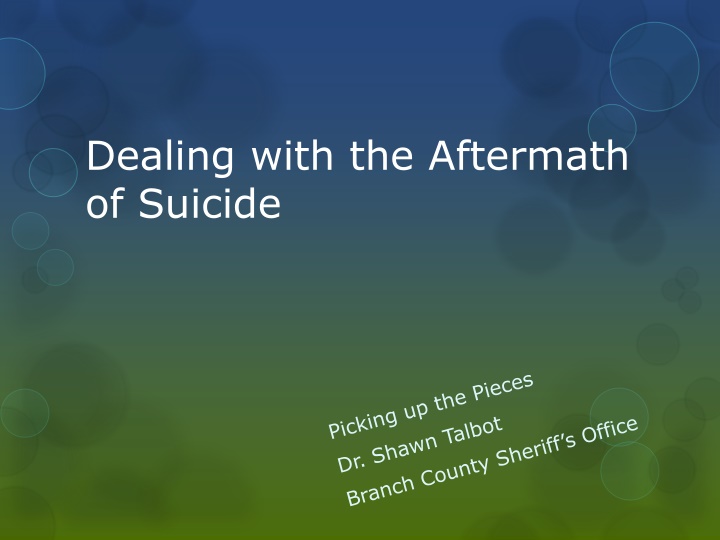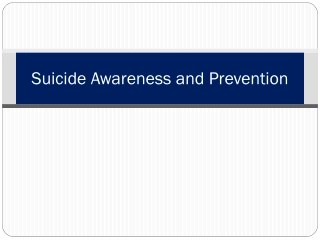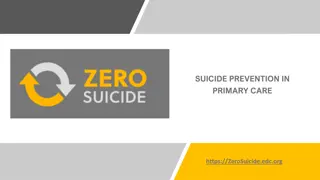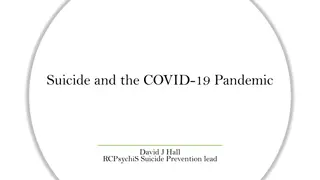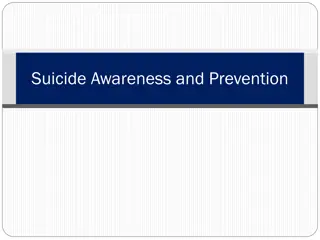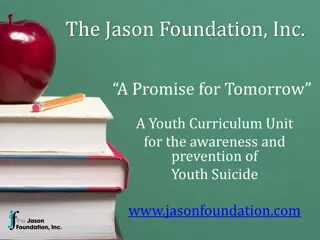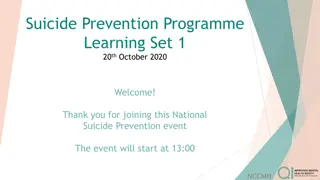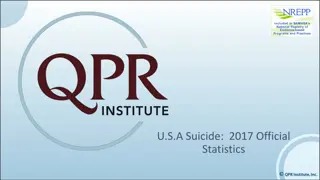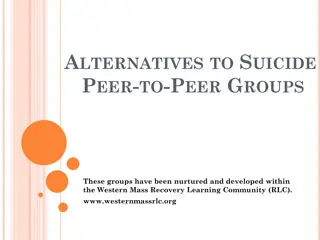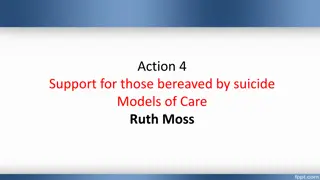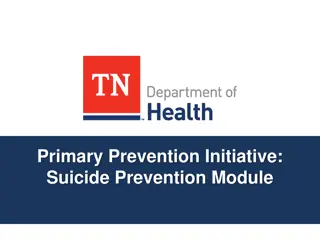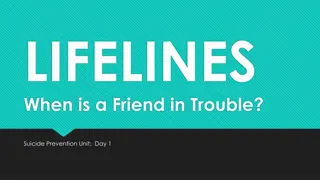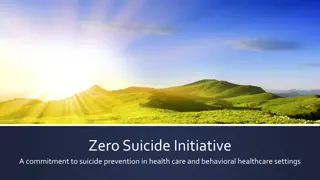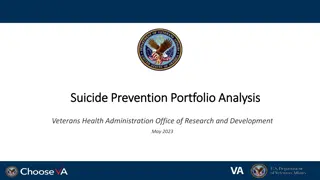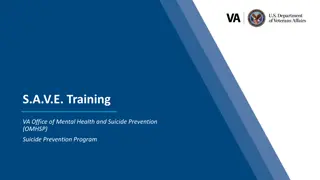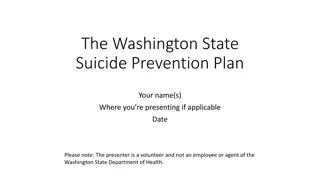Dealing with the Aftermath of Suicide
Understanding the impact of suicide, navigating the grieving process, recognizing common response sets to avoid, and exploring available resources for support. Delve into the nature of suicide, stages of grief, and how the dynamics of suicide influence the grieving process.
Download Presentation

Please find below an Image/Link to download the presentation.
The content on the website is provided AS IS for your information and personal use only. It may not be sold, licensed, or shared on other websites without obtaining consent from the author.If you encounter any issues during the download, it is possible that the publisher has removed the file from their server.
You are allowed to download the files provided on this website for personal or commercial use, subject to the condition that they are used lawfully. All files are the property of their respective owners.
The content on the website is provided AS IS for your information and personal use only. It may not be sold, licensed, or shared on other websites without obtaining consent from the author.
E N D
Presentation Transcript
Dealing with the Aftermath of Suicide
This Afternoons Goals Identify the Nature of Suicide Discuss issues related to the normal grieving process v. suicide Recognize response sets to avoid Become familiar with what can be done or offered. Review possible resources for the first responder.
Disclosure of Sources Michigan Association of Suicidologists (MAS) Michigan Association of Suicide Prevention (MASP) Elizabeth Kubler-Ross, 1983 Department of Justice, Federal Bureau of Intelligence Dr. Steve Band & Sp. Agent George Deshazor Michael McMains (San Antonio Police Department) Wayman Mullins (Southwest State University)
Why Prepare? The psychological states of emergency response personnel can have a direct effect on the mental and physical health of survivors of a trauma or disaster (Glasser, W. 1956)
Nature of Suicide MI. Prevalence (since 2001): 1,000 per year succeed 25,000 more attempts/gestures Michigan currently ranks 32ndamong other states. PINs Depression Lack of Control Over the Situation Male & Female Differences Women are 3x s as likely to attempt Men are 4x s as likely to complete Other Trends Increasing in children (increased by 70% since 1981) 3rdleading cause of death for 15 19 year olds Increasing in African Americans Highest with the Native American culture
Nature of Grief Grief v. Bereavement Stages of Grief Denial Anger Bargaining Depression Acceptance Kubler-Ross, E.
How does the dynamic of suicide affect this grief process? Theory 1: Suicide intensifies the grieving process (nature of the stressor). Theory 2: Suicide changes the grieving process due to the confusion often times surrounding it.
Stages of Grieving (revised) Denial Anger Bargaining Depression Acceptance Shock or Disbelief Guilt or Rage Helplessness/ Hypervigilance
What to Avoid In Our Responses Feigning Sympathy Over Empathizing ( I know how you are feeling. ) Ignore their pain or the pain in the situation. Using descriptive terms for the death (e.g. mode of death). Blaming the deceased. Trying to relieve their pain. Asking if there is anything they need or anything you can do (instead offer your availability).
What Can We Do? Understand the potential dynamics of suicide. Be prepared (e.g. 3 ring binder of resources, cards etc ). Demonstrate a professional level of empathy, understanding and respect (understanding your unique role, expressing condolences). Assess the situation for the possible need, either now or within the next few days, of professional mental health intervention (offering practical assistance) and assuring them that such can be helpful. Provide assurance in your mutual concern for understanding the situation and also providing supportive services (via referrals or the offering of available resources). Encourage the support of family and friends and discourage isolation. Let them know that healing can take place, but that it will take time (and that they have been through a traumatic event). Have resources available as/if needed. U.S. Department of Justice, Federal Bureau of Intelligence
Resources Suicide Support Groups The following link to suicide support groups comes from Suicide.org, http://www.suicide.org/suicide-support- groups.html. Click on the state to be directed to a list of suicide survivor support groups in that state. There is also a link to suicide support groups in Canada.
Kalamazoo Gryphon Place 1104 South Westnedge Kalamazoo, MI 49008 Name of Group: Survivors of Suicide Contact Person: Judy Whitehurst, LCSW (616) 381-4357 Meetings per Month: One - last Thursday of each month Fee: No Lansing Name of Group: Survivors of Suicide Child & Family Services, Capital Area 4287 Five Oaks Drive Lansing, MI 48911 Contact Person: Kathy Davis (517) 882-3506 Meetings per Month: One Fee: No
Resources Suicide Support Groups The following link to suicide support groups comes from Suicide.org, http://www.suicide.org/suicide-support-groups.html. Click on the state to be directed to a list of suicide survivor support groups in that state. There is also a link to suicide support groups in Canada. Websites for Suicide Survivors Listed here are a few websites that may be helpful for suicide survivors: For Suicide Survivors http://forsuicidesurvivors.com/index.html, devoted to those who are grieving the loss of a loved one by suicide. Suicide Survivors.org http://www.suicidesurvivors.org/, survivors of suicide help and information, Judy Raphael Kletter. Survivors of Suicide http://www.survivorsofsuicide.com/index.html Surviving Suicide http://www.survivingsuicide.com/cope.htm, provided by the surviving suicide support group of the Central Christian Church
Resources (continued) Recommended Books for Suicide Survivors What Children Need When They Grieve: The Four Essentials: Routine, Love, Honesty and Security, by Julia Wilcox Rathkey. Helping Children Grieve: When Someone They Love Dies (Revised Edition), by Theresa Huntley. Helping Children Cope With the Loss of a Loved One: A Guide For Grownups, by William C. Kroen and Pamela Espeland. Guiding Your Child Through Grief, by James P. Emswiler and Mary Ann Emswiler. Grieving Child, by Helen Fitsgerald. Breaking the Silence: A Guide to Help Children with Complicated Grief-Suicide, Homicide, AIDS, Violence and Abuse, by Linda Goldman. Books for children about suicide include: After A Parent s Suicide: Helping Children Heal, by Margo Requarth. After A Suicide: A Workbook For Grieving Kids, developed by the Dougy Center for Grieving Children. But I Didn t Say Goodbye: For Parents and Professionals Helping Child Suicide Survivors, by Barbara Rubel. Someone I Love Died by Suicide: A Story for Child Survivors and Those Who Care for Them, by Doreen Cammarata. General guidelines on suicide are covered in the following books: After Suicide: A Ray of Hope for Those Left Behind, by E. Betsy Ross and Joseph Richman. After Suicide: Help for the Bereaved, by Dr. Sheila Clark. Healing After the Suicide of a Loved One, by Ann Smolin and John Guinan. Silent Grief: Living in the Wake of Suicide, by Christopher Lucas and Henry M. Seiden. Touched by Suicide: Hope and Healing After Loss, by Michael F. Myers and Carla Fine. Aftershock: Help, Hope and Healing in the Wake of Suicide, by Candy Neely Arrington and David Cox. After Suicide, by John H. Hewett.
Thank You Contact Information: Dr. Shawn Talbot 517.677.9224 (cell) 269.965.3931 ext. 2220 talbots@kellogg.edu
